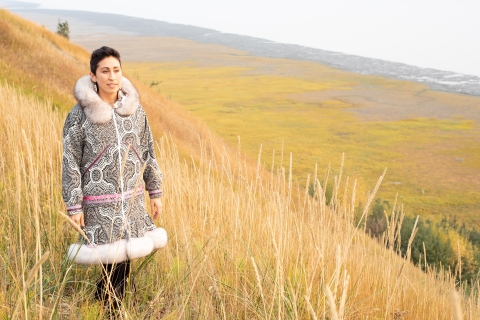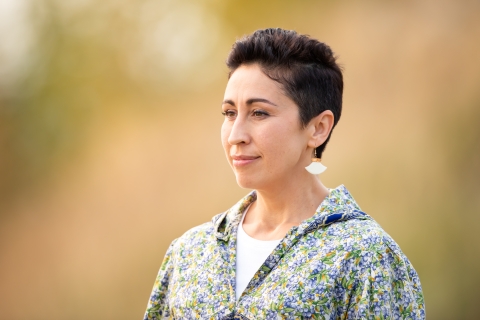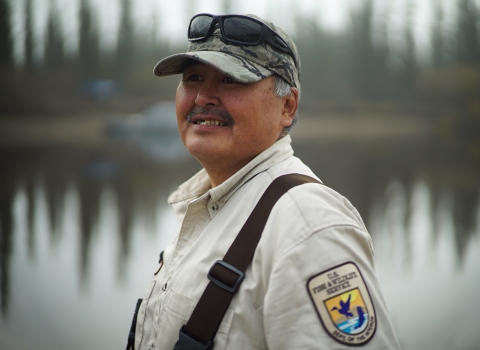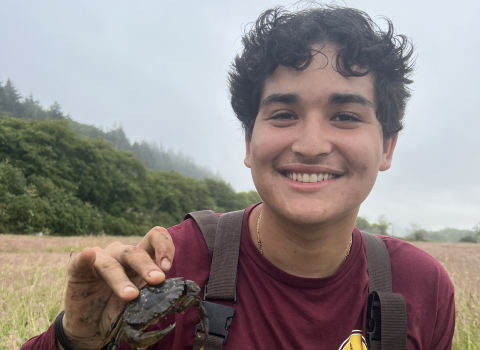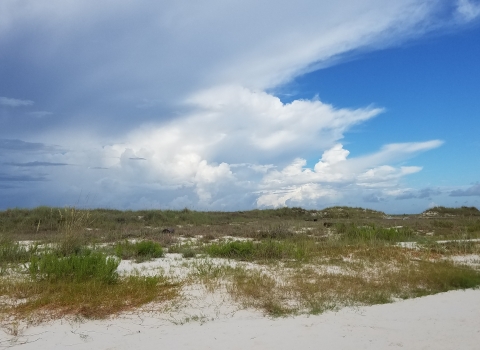Whoever wants that job is crazy!” That was Crystal Leonetti’s reaction when she first heard about a job opening with the U.S. Fish and Wildlife Service (Service) in Alaska. Crystal was already working for the Natural Resources Conservation Service (NRCS), a federal agency she’d been affiliated with since high school. NRCS was about conserving resources, not regulating them.
“The people who regulate our way of living, of surviving and being who we are,” she said, “they have had a bad reputation in the villages.”
Well, here’s a surprise: Crystal ended up taking that job herself. She’s now in her tenth year as an Alaska Native liaison with the Service. The reasons behind her choice are meaningful and worth understanding. Let’s start with how Crystal introduces herself. She begins in Yupik.
“Waqaa! Ciisquugua. Quyana Tailuci!” [“What’s up! My name is Ciisquq. Thank you for being here.”]
She continues in English: “My Yupik name is Ciisquq. My mom and dad are Al and Grace Poindexter from Anchor Point. And, my maternal grandparents are Daisy and the late Harry Barnes from Dillingham. My paternal grandparents are the late Chuck and Beulah Poindexter from Anchor Point. I am married to my best friend Ed, and we have 2 daughters, Audrey and Gigi.”
Only at the very end, she adds,
“I am the Alaska Native Affairs Specialist from the U.S. Fish and Wildlife Service.”
To this day, Crystal teaches her agency colleagues to save their job title for the end of any introduction. “Native people want to know your heart,” she says. Naming your ancestors means you accept responsibility to behave a certain way, that you will be accountable.
This is the seed of trust with any Alaska Native community. She shares concrete stories about the difference it makes in government and tribal relationships. So why did Crystal take a job with an agency that historically has caused anguish among Alaska Native peoples? First, many people who knew her thought she’d be good at it. During her 16 years at the NRCS, she’d earned the title of peacemaker between tribes and her agency.
With such widespread encouragement to take the job, she sought advice from elder Larry Merculieff. “As elders do, he had a completely different thought process,” she said, smiling. “He asked, ‘Do you wonder why Mother Earth is crying?’” Crystal found his question frustrating; she had her own answers.
But, he continued. “People don’t take care of Mother Earth because they don’t respect themselves. In turn, they treat others badly. We have to work on respecting and loving ourselves first, in order for Mother Earth to heal. And the Fish and Wildlife Service needs to heal from the inside out.” He never told her to apply for the job. Instead, he suggested she go somewhere quiet, somewhere where she could stop thinking. “An answer will come to you,” he promised.
So, she sat beside the ocean near her home in Anchor Point and did as he said. She stopped thinking. After a time, when she climbed back up the hill from the sea, she was calmed by a sense of deep peace. She had her answer. “I am going to apply for this job,” she told herself. “And if I get it, I am going to pour my whole heart into it.”
She succeeded, becoming the first Indigenous woman to ever serve as a U.S. Fish and Wildlife Service Native American liaison. Crystal entered the agency optimistic that by 2009, racism was waning before a tide of open-heartedness, of growing tolerance and acceptance. And, indeed, she found right actions, if not always-right results.
She describes an early meeting at which Native liaisons from various agencies were called together to give advice on forming tribal consultation policy. Clearly, a good result. But, “Everything we said was immediately dismissed, thrown away, passed over,” she said. “I had never been treated like that before. I was in shock.” A bad result.
Her first few years at the agency were like that. None of it was overt, she said. “It was graceful, in a way.” She’d be greeted with warmth, with, “Oh, it’s so nice to see you...”
Then she’d share her expertise, her training, her education as a way to build a relationship with tribes and Alaska Native people. To no avail: “It was like I was just filling a space for a few minutes, and they’d forget all about it when I left the room.”
But, eventually, attitudes and responses began to change. And, Crystal had lessons to learn, too. She came to appreciate the work of her colleagues, to understand their roles (not all regulatory) were focused on conserving resources. She saw that the agency and resource users share this value, and that, particularly in Alaska, they recognized the interconnection between people and the land. Plus, there were important breakthroughs.
Crystal was approved to bring to the Service the first ever Alaska Native Relations training she’d experienced with NRCS. In it, elders teach a history that begins long before Vitus Bering ever spotted Alaska. Students learn how diverse Native groups are, how rich they are in arts, food, dance and life — ways.
Her colleagues’ reaction was electric: “People were like, ‘Why haven’t we had this before? This is amazing…” So, Crystal and the agency’s chief law enforcement officer approached the regional director, requesting permission to make the training more broadly available. He endorsed the idea, even making it mandatory.
The agency has 600 employees in Alaska. Twice a year Crystal leads 40 of them through the Native relations program. She’s confident it makes them more comfortable and more aware as they approach tribal groups to discuss wildlife management.
“I view my job as educating my colleagues,” she said. “So many of the mistakes we’ve made in our history are from not knowing. My colleagues are not malicious. They don’t mean to do harmful things to Native people. They just don’t know; they don’t understand their impact.”
Keeping that awareness in daily thinking has changed policies. It became the springboard for better relations in an important federal and tribal co-management council for migratory birds. “Now, traditional knowledge is treated with the same importance as the Western science and the academia and the published papers,” Crystal said. “Conservation happens, and it happens in a respectful way so the subsistence community is not harmed.”
And, very significantly, twice now, the U.S. Fish and Wildlife Service has issued formal apologies for historical actions that harmed Alaska Natives. The first, in 2017, acknowledged injury to Aleut families evacuated by Service vessels to an abandoned fish cannery at Funter Bay on Admiralty Island in 1942, six months after the United States declared war on Japan. They stayed 2 years; 47 people died.
“For loved ones lost, and for internees who suffered from hunger, coldness, and illness, I am sorry,” Jim Kurth, the agency’s acting director at the time, told a gathering on St. Paul Island (read more).
More recently, two agencies — Alaska Department of Fish and Game and the U.S. Fish and Wildlife Service — jointly apologized for historical policies that forbade spring harvesting of migratory birds, a nutritional necessity for Alaska Natives after winter’s depleted food stores. Many hunted illegally, and suffered emotional, physical and legal consequences. In their 2018 apology, the agencies wrote, “We recognize your tenacity, your brave vision, and your resilience in the face of the insensitivity of the past harvest regulations…We ask your forgiveness…” Crystal’s contributions, and the powerful work of her colleagues, are manifest; from the inside out, the agency is healing.
In Alaska we are shared stewards of world renowned natural resources and our nation’s last true wild places. Our hope is that each generation has the opportunity to live with, live from, discover and enjoy the wildness of this awe-inspiring land and the people who love and depend on it.
This story first appeared in Conservation History’s 2020 “Women in Conservation” issue. Written by Kathleen McCoy, Independent Journalist. Complied here by Katrina Liebich.

